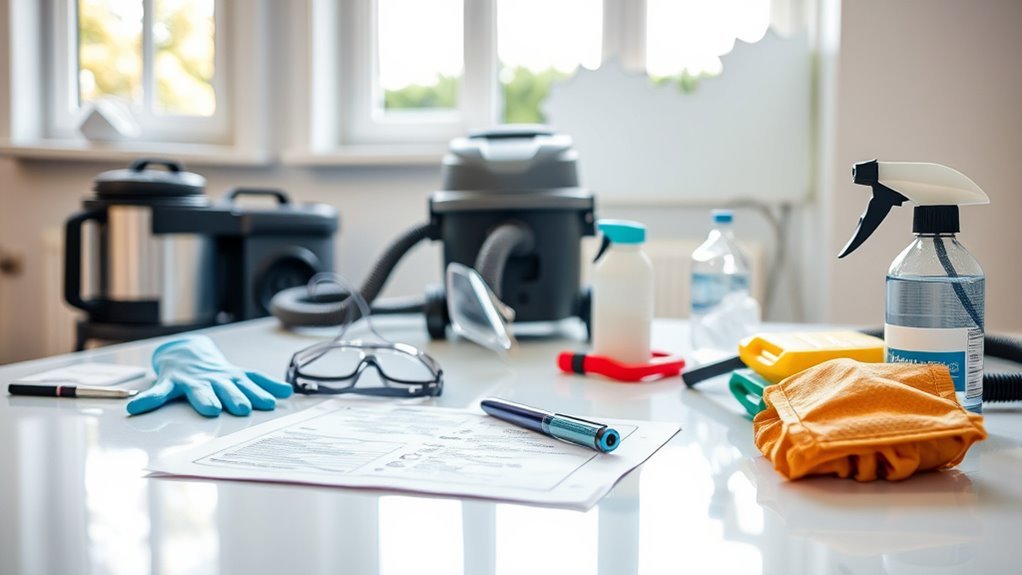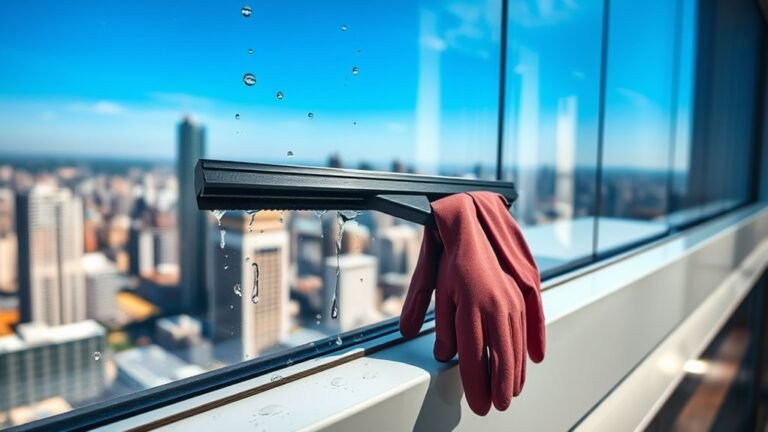Cleaning Checklist for Mold Businesses
You’ll need a strict cleaning checklist covering PPE selection per OSHA standards, initial mold assessment with containment barriers, and safe removal of all contaminated materials following EPA guidelines. Use EPA-approved disinfectants, HEPA vacuuming to trap spores, and air scrubbing with ventilation adjustments to control airborne contaminants. Moisture must be controlled below 60% to prevent recurrence. Final inspections with clearance testing confirm safety and compliance. Further steps guarantee thorough risk management and operational integrity.
Personal Protective Equipment (PPE) Requirements

Personal Protective Equipment (PPE) is essential in mold remediation to safeguard workers from hazardous exposure. You must select appropriate PPE types based on the mold contamination level, adhering strictly to safety standards like OSHA and NIOSH. Essential PPE includes respirators with HEPA filters, disposable coveralls, gloves resistant to mold and chemicals, and eye protection. Ensuring a proper fit and integrity of PPE is critical to prevent airborne mold spores from compromising your health. Regular training on donning and doffing PPE reduces cross-contamination risks. Compliance with regulatory requirements not only protects your freedom to work safely but also minimizes liability. By rigorously following PPE protocols, you maintain control over hazardous environments while safeguarding your team’s well-being and operational integrity.
Initial Mold Assessment and Containment Setup
Before beginning mold remediation, you’ll need to conduct a thorough initial mold assessment to identify contamination scope and severity. Employ advanced mold identification techniques, such as surface sampling and air quality testing, to pinpoint affected areas accurately. This precision guarantees compliance with industry standards and regulatory guidelines. Once identified, implement containment strategies to prevent cross-contamination and protect unaffected zones. Effective containment limits mold spore dispersion and safeguards occupants.
Key steps include:
- Utilize negative air pressure chambers with HEPA filtration to isolate remediation zones.
- Seal off HVAC vents and doorways using polyethylene barriers and tape.
- Establish decontamination units for personnel and equipment to maintain site integrity.
Removal of Contaminated Materials

You need to accurately identify all materials contaminated by mold to prevent cross-contamination and guarantee effective remediation. Follow strict protocols for the safe removal and disposal of these materials in accordance with local and federal regulations. Proper handling minimizes health risks and environmental impact during the cleanup process.
Identifying Contaminated Materials
Accurately identifying contaminated materials is critical to effective mold remediation and regulatory compliance. You need to distinguish mold types and contamination sources to assess which materials pose health risks or structural damage. Focus on detecting visible mold growth, water damage indicators, and musty odors. Prioritize porous materials, as they often harbor deeper contamination.
Key considerations include:
- Differentiating between surface mold and embedded mold within materials to determine removal necessity
- Recognizing contamination sources such as plumbing leaks, HVAC systems, or floodwaters for targeted remediation
- Evaluating the extent of contamination on materials like drywall, insulation, and carpet to comply with environmental safety standards
This precise identification guarantees you’re removing only compromised materials, preserving unaffected areas and adhering to regulatory protocols.
Safe Disposal Procedures
When handling contaminated materials, it is essential to follow strict disposal protocols to prevent cross-contamination and comply with environmental regulations. You must employ approved mold disposal techniques, ensuring that all affected items are sealed in impermeable bags or containers labeled as hazardous waste. Avoid breaking or crushing materials to minimize spore release. During hazardous waste handling, wear appropriate personal protective equipment and use designated transport containers. Coordinate with licensed disposal facilities that follow EPA and local guidelines for mold-contaminated waste. Document all disposal actions meticulously to maintain regulatory compliance and support traceability. By adhering to these procedures, you protect public health, the environment, and your operational freedom, while ensuring that mold waste is managed responsibly and legally.
Cleaning and Disinfecting Surfaces
You’ll need to select disinfectants approved by regulatory agencies for mold remediation to guarantee efficacy and safety. Before applying any disinfectant, thoroughly prepare surfaces by removing visible mold and debris to maximize contact and penetration. Proper surface preparation and disinfectant choice are critical steps to meet industry standards and prevent mold recurrence.
Effective Disinfectant Choices
Although selecting the right disinfectant can be complex, it’s crucial to choose products that meet Environmental Protection Agency (EPA) standards for mold remediation. You need to prioritize disinfectant effectiveness, guaranteeing the agent not only kills mold spores but also prevents regrowth. Consider eco friendly options that align with regulatory compliance and minimize environmental impact without compromising performance. When making your choice, focus on:
- EPA-registered disinfectants specifically labeled for mold and mildew control
- Products with proven residual activity to maintain prolonged antimicrobial effects
- Low-toxicity formulations that guarantee user safety and reduce harmful chemical exposure
Surface Preparation Techniques
Selecting the right disinfectant sets the stage for effective surface preparation in mold remediation. You must apply precise surface preparation methods tailored to the substrate involved. Begin with thorough substrate assessment techniques to identify material porosity and contamination extent, ensuring compliance with industry standards. Proper cleaning removes organic matter, enabling disinfectants to work efficiently.
| Surface Type | Preparation Method | Assessment Technique |
|---|---|---|
| Porous (e.g., wood) | HEPA vacuuming + detergent wash | Moisture meter + visual inspection |
| Non-porous (e.g., metal) | Detergent wipe + disinfectant spray | Surface swab + ATP test |
| Painted surfaces | Gentle detergent wipe | Visual inspection + adhesion test |
Adhering to these protocols safeguards your remediation process, granting you operational freedom within regulatory frameworks.
HEPA Vacuuming Procedures

HEPA vacuuming plays a critical role in controlling mold contamination by capturing microscopic spores and preventing their redistribution into the environment. When you perform HEPA vacuuming, you must adhere strictly to established vacuuming techniques to guarantee effective spore removal and regulatory compliance. Regular HEPA filter maintenance is essential to maintain suction efficiency and prevent cross-contamination.
HEPA vacuuming is essential for mold control, ensuring spore removal and preventing environmental redistribution.
Key considerations include:
- Use slow, overlapping strokes to maximize spore capture without disturbing settled mold particles.
- Replace or clean HEPA filters per manufacturer guidelines to maintain filtration integrity.
- Vacuum all accessible surfaces, including walls, floors, and HVAC components, to reduce airborne spores effectively.
Following these precise procedures empowers you to maintain a mold-free environment while meeting industry standards and preserving your operational freedom.
Air Scrubbing and Ventilation Controls
When you’re managing mold remediation, controlling airborne contaminants through air scrubbing and ventilation is essential to meet regulatory standards and protect indoor air quality. You must deploy high-efficiency air scrubbers equipped with HEPA filters to capture mold spores and particulate matter effectively. Position these units strategically within containment areas to maintain negative pressure, preventing spore migration. Additionally, make certain that ventilation systems are evaluated and adjusted to optimize airflow, facilitating contaminant removal without cross-contamination. Regularly monitor air quality using calibrated instruments to verify that particulate levels stay within permissible limits. Maintaining these controls not only complies with OSHA and EPA guidelines but also grants you operational freedom by minimizing health risks to workers and occupants. Precision in air scrubbing and ventilation makes certain your mold remediation remains both effective and compliant.
Moisture Control and Prevention Strategies
Controlling airborne contaminants through air scrubbing and ventilation only addresses part of the mold remediation challenge. You must also focus on moisture control and prevention strategies to achieve lasting results. Identifying and eliminating moisture sources is critical, as unchecked dampness fosters mold growth. Effective humidity control maintains indoor levels below 60%, minimizing potential fungal proliferation.
To implement robust moisture control, consider:
- Inspecting plumbing, roofing, and foundation areas for leaks or water intrusion
- Utilizing dehumidifiers and HVAC systems calibrated to maintain ideal humidity levels
- Ensuring proper site drainage and grading to divert water away from structures
Adhering to regulatory guidelines on moisture management empowers you to prevent mold recurrence, protecting both your business reputation and client health while preserving your operational freedom.
Final Inspection and Clearance Testing
Although thorough remediation reduces mold risks, you still need to conduct a final inspection and clearance testing to verify that all contaminants have been effectively removed and that the environment meets industry and regulatory standards before reoccupancy. During the final inspection, you’ll systematically assess all treated areas for residual moisture, visible mold, and structural integrity. Clearance testing follows, employing air and surface sampling analyzed against established threshold limits to confirm that mold spore concentrations are within acceptable ranges. You must guarantee all documentation complies with regulatory requirements, providing a transparent record of remediation efficacy. This step not only safeguards occupant health but also grants you the freedom to confidently declare the space safe. Skipping or inadequately performing these tasks risks non-compliance and undermines the integrity of your mold remediation efforts.
Frequently Asked Questions
How Do Mold Businesses Handle Customer Communication During Remediation?
When handling customer communication during remediation, you should implement clear communication strategies to keep clients informed about progress and safety measures. Regular updates and transparency guarantee compliance with regulatory standards and build trust. Encouraging and documenting customer feedback allows you to adjust processes and enhance service quality. By prioritizing open dialogue, you maintain control while respecting clients’ need for freedom and confidence throughout the remediation process.
What Insurance Coverage Is Recommended for Mold Remediation Companies?
For mold remediation companies, securing solid safeguards like liability insurance and pollution coverage is paramount. Liability insurance limits legal liabilities linked to property damage or bodily injury during mold removal, while pollution coverage protects against environmental exposures and contamination claims. You’ll want to carefully comply with regulatory requirements, ensuring extensive coverage that provides freedom from financial fallout. Prioritize policies tailored to your operations, so you’re protected against unpredictable risks in this specialized sector.
How Often Should Mold Remediation Equipment Be Serviced or Replaced?
You should follow strict service frequency guidelines for equipment maintenance to guarantee peak performance and compliance with regulations. Typically, mold remediation equipment must be serviced after every major job or every three to six months, depending on usage intensity. Replace parts showing wear or damage promptly to avoid failures. Staying proactive with maintenance not only extends your equipment’s lifespan but also keeps your operations safe and effective, giving you the freedom to focus on quality remediation work.
Are There Specific Certifications Required for Mold Remediation Professionals?
Think of certification programs like a passport, granting you access to industry standards and professional freedom in mold remediation. You’ll need specific certifications, such as those from the IICRC or NORMI, to comply with regulatory requirements. These programs guarantee you meet technical proficiency and safety protocols, protecting both you and your clients. Staying certified means you’re authorized to operate confidently within the mold remediation field, maintaining credibility and legal compliance.
What Are Common Challenges Faced During Mold Remediation Projects?
When tackling mold remediation projects, you’ll often face challenges like accurately identifying mold species using mold detection techniques, which is essential for compliance. Ensuring containment to prevent cross-contamination is another hurdle. You’ll need to strictly follow remediation best practices, including proper personal protective equipment and disposal protocols, to meet regulatory standards. Balancing thorough cleanup with minimal disruption can be tough, but mastering these aspects gives you the freedom to deliver safe, effective results.






